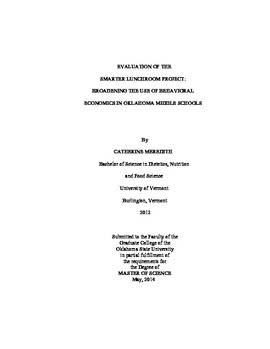| dc.contributor.advisor | Hildebrand, Deana | |
| dc.contributor.author | Meredith, Catherine Angela | |
| dc.date.accessioned | 2015-06-17T20:07:02Z | |
| dc.date.available | 2015-06-17T20:07:02Z | |
| dc.date.issued | 2014-05-01 | |
| dc.identifier.uri | https://hdl.handle.net/11244/15008 | |
| dc.description.abstract | Childhood obesity is a major problem for American youth. Evidence suggests consumption of fruits and vegetables contributes to a healthy weight. The school environment and National School Lunch Program (NSLP) are fundamental in supporting healthy eating behaviors, including fruits and vegetables, but forcing these behaviors may be counterproductive. Recent research suggests that use of behavioral economic (BE) strategies in school nutrition settings influences students to choose healthy foods. The low or no cost BE strategies are simple, making them appropriate for use in schools.The purpose of this study, referred to as the Smarter Lunchroom Project, was to broaden use of BE in Oklahoma middle schools, identify factors associated with implementing BE principles, and examine the effects on students' fruits and vegetables selections. This community-based project trained Cooperative Extension Family and Consumer Science Educators to recruit middle schools from their respective counties, and train managers on incorporating Smarter Lunchroom strategies into their lunchrooms. Of the 69 recruited middle schools, 32 schools agreed to participate. The 8-week intervention was conducted in spring 2013. Data related to school demographics, the school lunchroom environment, use of BE strategies, and managers' attitudes, were collected using the Smarter Lunchroom Action Plan and Follow-up forms. Two sets of six-weeks of food production records, one from fall 2012, and one from the intervention period (weeks 3 through 8) were used for analysis of fruit and vegetable servings. Findings revealed a significant increase in the use of BE strategies. Managers' support of BE was high throughout the project and varied from very supportive to supportive. There was a moderate, positive correlation between managers' support and extent of BE strategy use. There was no increase in fruit and vegetable servings after the implementation of BE strategies, which may be due to timing of the project, and the recent implementation of the new NSLP meal pattern requirements. Use of the Diffusion of Innovation Theory may be useful in future efforts to further expand use of BE strategies in school cafeterias. Further research is needed to study the interaction of new meal pattern requirements and BE on students' food choices. | |
| dc.format | application/pdf | |
| dc.language | en_US | |
| dc.publisher | Oklahoma State University | |
| dc.rights | Copyright is held by the author who has granted the Oklahoma State University Library the non-exclusive right to share this material in its institutional repository. Contact Digital Library Services at lib-dls@okstate.edu or 405-744-9161 for the permission policy on the use, reproduction or distribution of this material. | |
| dc.title | Evaluation of the Smarter Lunchroom Project: Broadening the Use of Behavioral Economics in Oklahoma Middle Schools | |
| dc.type | text | |
| dc.contributor.committeeMember | Kennedy, Tay | |
| dc.contributor.committeeMember | Gates, Gail | |
| osu.filename | Meredith_okstate_0664M_13190.pdf | |
| osu.accesstype | Open Access | |
| dc.description.department | Nutritional Science | |
| dc.type.genre | Thesis | |
| dc.subject.keywords | behavioral economics | |
| dc.subject.keywords | middle school | |
| dc.subject.keywords | oklahoma | |
| dc.subject.keywords | school lunch | |
| dc.subject.keywords | smarter lunchrooms | |
